Create is a mod for Minecraft offering a variety of tools and blocks for construction, decoration and aesthetic automation.
The technological elements added by the Create mod are designed to leave as many design choices to the player as possible, where processing objects does not occur within a single block with fun textures, it requires a set of actors working together in many possible arrangements.
Some of the most important machines and components require a rotating force to function. Sometimes the speed and direction of rotation provided reflects their behavior, and some components may have a higher cost than others. Trying to understand how these components work together can become difficult. So we recommend you read the tutorial below.
Producing and transmitting with Create Mod
Many of the machines in Minecraft Create mod need power to operate. This power can be called rotational force or simply Rotation. There are several different components that can create this rotational force in one way or another, they are called generators. However, generation alone will only get you so far, it still needs to be relayed to the desired machines. There are a variety of different blocks in Create that can do this. It is best to play around with each component to familiarize yourself with its capabilities. It’s important to know the options when faced with complex connection tasks in a potentially less than forgiving environment. Below is a list of some generators as well as ways to get the rotational force where it is needed with some quick explanations.
Multiple generators can be connected together to get a better capacity score for the attached kinetic network. When attaching new generators to running components, it is important that the added generator rotates in the same direction as the component it is attached to. If you connect two kinetic blocks with incompatible directions of rotation, you will notice that the blocks break. However, it is very easy to solve this problem: just include a way to reverse the rotation between the generator and the rest of the block.
Generators
Water wheel

One of the most basic generators is called the water weel. This concept should sound familiar, especially to people who have played Minecraft with mods for a while. To make it spin, all you have to do is make water flow around it. Pay attention to the direction the water is flowing, as it will only turn halfway if the water is flowing in the wrong direction.
Encased fan
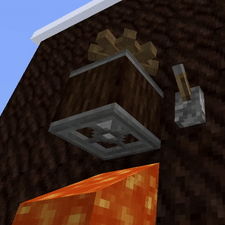
Encased fans are a little more advanced. While they can act as a spin consumer, they can also provide spin! To turn an encased fan, it must face down and have a heat source (e.g. fire or lava) directly below it. Then, simply apply a Redstone signal to the fan and it will spin.
Furnace engine
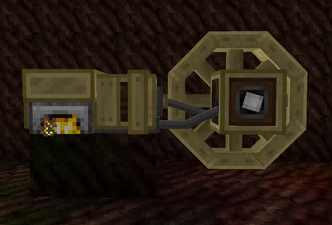
The furnace engine is more expensive to produce than the other two generators, but it is rewarded with much more load capacity. First of all, you will need 2 parts to make this generator work: The furnance engine itself, and a flywheel. The engine must be placed on an oven, and then the flywheel can be attached. To make this multiblock work, you have to turn on the oven. That’s it. But beware, once your furnace turns off, the motor and all your connected machines turn off as well!
Conveyors
Shaft

The Shaft is the simplest and most economical way to transfer rotational force. It relays the rotation in a straight line to all connected shafts.
Shafts are also available in a recessed version. They have the same functionality, but look a little different.
Cogwheels

Although Cogwheels can be used as decorative shafts, their main use is a little different. They transmit rotation laterally to other gears while maintaining the axis of rotation. Directly adjacent gears also reverse the direction of rotation.
When a large and a small gear wheel are mixed, the speed of rotation also changes.
Two large sprockets at a 90° angle allow the axis of rotation to be changed.
Belt
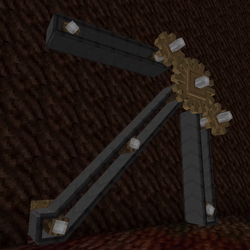
To place belts, you need two shafts facing the same direction. They can be placed in 3 orientations, horizontal, vertical or diagonal at a 45° angle (see below for some examples). Click on the first tree and you will see particle effects where you look. When you look at a second valid tree, these particles will turn green. Once you put a belt in place, it will relay the rotation between the two trees while keeping the rotation and speed the same. You can also click a shaft onto any piece of a belt to insert an additional pulley to which you can connect components. Belts can also move objects.
Encased chain drive
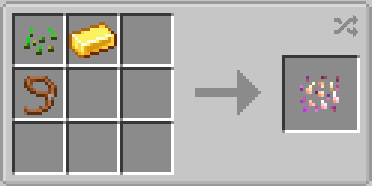
Encased Chain Drives don’t transfer objects, but are a bit more versatile than their normal counterparts when it comes to transmitting rotation. You can connect any number of drive chains in a straight line to form a small array that will transmit the same rotation and speed. They will change texture to show a correct connection if done correctly. This way you can also change the axis of rotation a little easier.
The adjustable chain shift is a more advanced version of a recessed chain drive that also allows you to change the speed.
Gearbox
The Gearbox is a simple block that relays rotation between 4 of its sides while reversing the straight connections.
Gearshift
The Gearshift is a simple block that acts like a shaft when not powered, but reverses the direction of rotation when a Redstone signal is applied.
Clutch
The Clutch is a simple block that acts like a shaft when not powered, but stops rotation completely when a Redstone signal is applied.
Shifting gears
It’s not enough to just make the components rotate. Sometimes it is necessary to have better control over the speed of rotation. This is especially important for machines that require a minimum level of speed to operate (for example, the mechanical mixer). To do this, some kinetic blocks have the ability to speed up or slow down the connected components:
Gears
Gears are not only useful for relaying rotation, but also serve as a simple way to control speed. By attaching a large gear diagonally to a full-size gear, as shown below, you can double/divide the speed of the other.
- By powering the large gear, the small gear turns at double speed.
- By powering the small sprocket, the large sprocket rotates at half the speed.
Adjustable Chain Shift
The adjustable chain shift, when used in combination with recessed chain drives, provides finer speed control than sprockets. It can increase the input speed of chain drives or decrease the output speed of shafts connected to chain drives.
While acting as an input, the adjustable chain shifter will increase the speed of embedded chain drives based on the analog redstone signal it receives. A full power of 15 will double the speed of all chain drives while lower values will interpolate the factor from 2x to 1x.
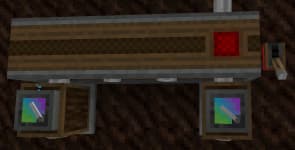
While acting as an output, the adjustable chain shifter will decrease the speed of the connected shaft. A power of 15 will reduce the speed by half and lower values will interpolate the factor from 0.5x to 1x.
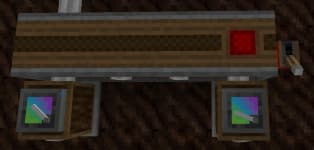
When not powered, the chain reducer does not affect speed at all and behaves like a built-in chain drive.
Rotation speed controller
Although it has a more expensive recipe, the RSC also has the finest control over the speed change. When a large sprocket is attached to the top of the controller, the controller does its best to spin it at the speed configured in the scroll field. If you hold down the shift key while scrolling, the speed will increase/decrease by 1.
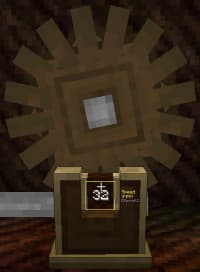
Overpower
By connecting faster components directly to other slower components, the faster network will override the rest, aligning the speed of the component network (i.e. if the direction is aligned).
Load units, capacity and impact
Now that we’ve covered Rotation and Velocity, we need to talk about the last important mechanism: load (Stress). Load is the Create mod’s simplified implementation of torque, which balances the rotation. To understand the load, we need to divide the components into two groups: generators and consumers. Generators have some load capacity associated with them, while consumers have a load impact. As long as the total capacity of a system is greater than or equal to the total impact, the system is running and all components are working. If, however, the total load impact becomes too great, the system will experience an overload, preventing all components from operating. This condition persists until the impact is reduced or capacity is added.
SU and speed
The amount of load on a component also depends on its current speed. All components have a certain base value, which corresponds to a speed of 1 RPM. To get the effective impact or capacity, simply multiply this base value by its current speed. For example, a water wheel (base value of 4 SU) running at 5 RPM will add a total of 20 SU of capacity to the system, while the same wheel running at 10 RPM will add 40 SU. The same logic applies to consumers: A grinding wheel running at 20 RPM adds 160 SU of impact to the system.
By default, components used only to relay rotational power, such as shafts and gears, have no stress impact. This makes predicting the amount of generators needed for your machines much simpler and avoids punishing aesthetic detours between machines and generators.
Quick example
In the end, this means that if you want to run 2 crusher wheels, you’ll need 4 hydraulic wheels running at the same speed or you can get by with just one if you slow the crusher down to a quarter speed instead.
Goggles and gauges
Optimizing the impact of stress and comparing net source capacity to base speed can get pretty scientific. For those who want to see real numbers and more comprehensive information, it is recommended to look into making a pair of goggles and a strain gauge :
Statistics of a Hydraulic Wheel Running at 10 RPM:

Statistics of a crushing wheel running at 20 RPM:

Example of a load gauge on a busy network:
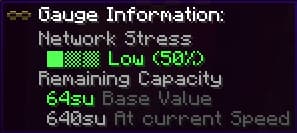
Creations in Minecraft with Create Mod
Download the Create Mod
This mod requires the installation of Minecraft Forge. Learn how to install a mod on Minecraft.
If you install the mod on a server, you also need to install Flywheel.


